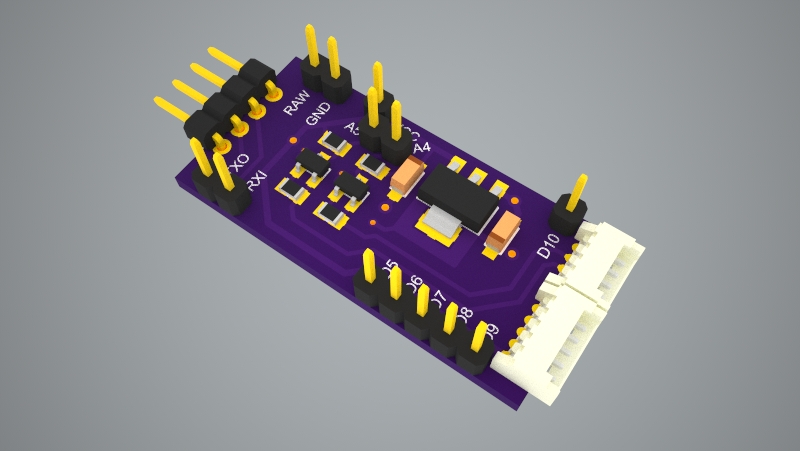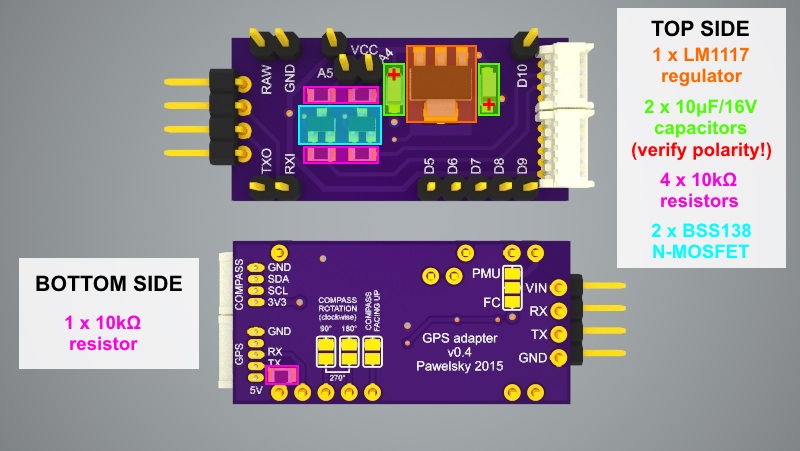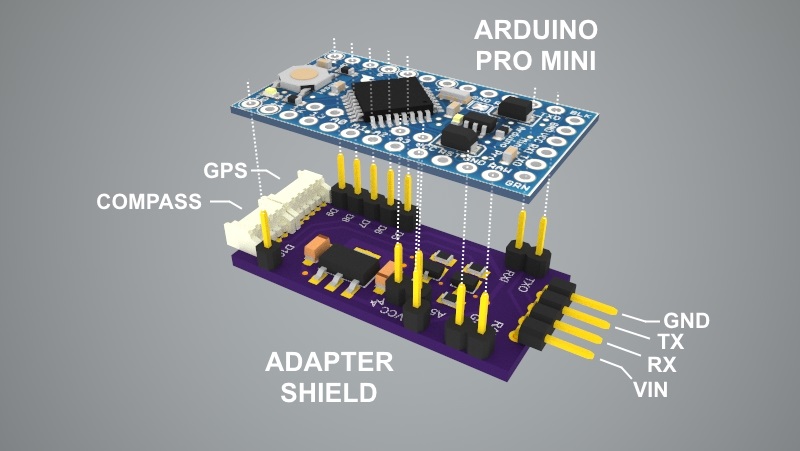
OSH Park
APM 2.6 GPS to Naza adapter v0.4
APM 2.6 GPS to Naza adapter v0.4
by
2
layer board of
1.45x0.70
inches
(36.83x17.78
mm).
Shared on
May 8th, 2015 19:37.
This Arduino Pro Mini shield allows to convert data coming from APM 2.6 GPS/compass combo into various other formats required.
One of the interesting examples is conversion into Naza (Lite/v1/v2) flight controller format, making it (together with a uBlox Neo 6M or Neo M8N and HMC5883L compass module) an alternative for the original Naza GPS puck.
More details about this particular conversion can be found in this RC Groups thread: http://www.rcgroups.com/forums/showpost.php?p=30011989&postcount=1
Following components are needed to assemble the adapter:
- 1 * TI LM1117 fixed 3.3V LDO regulator in SOT-223 package
- 2 * Tantalum 10uF/16V capacitors in SMD A package
- 2 * BSS138 N-MOSFET in SOT-23 package
- 5 * 10kΩ resitor in 0805 package
- 1 * 1x13 straight 2.54mm header pins (divided into 1, 1, 2, 2, 2, 5 sections)
- 1 * 1x4 right angle, low profile 2.54mm header pins (e.g. Adam Tech PH1RB)
- 1 * 4 pin Molex Picoblade 1.25 mm, right angle connector (MX-53048-0410)
- 1 * 5 pin Molex Picoblade 1.25 mm, right angle connector (MX-53048-0510)
- 1 * Arduino Pro Mini 16MHz/5V board (with Sparkfun compatible pinout - A4/A5 pins broken out next to A2/A3)
If you also want to add a reverse polarity protection (so the board is not fried when the power is connected the wrong way) you’ll need and additional P-Channel MOSFET and an enhanced (v0.5) version of the PCB. Details can be found HERE. Other than the extra MOSFET the rest of the board assembly is the same as below.
Here is how the shield looks like when assembled

Picture below presents how the components are placed on the shield (both sides):

Note the VIN - PMU/FC solder pads at the bottom of the board. You should have these soldered in order for the adapter to work:
- when powering with 5V - solder VIN pad with FC pad
- when powering with more than 5V - solder VIN pad with PMU pad (note that in this case the Adrduino’s built in power regulator will be used to power everything so you must not exceed its voltage and current limitations)
Here you will find an explanation on where the “strange” FC/PMU naming convention comes from.
Here is how the shield shall be stacked together with Arduino Pro Mini board

Credit goes to MCfuturegame .. for the Arduino Pro Mini model used in the above rendering.
This shield is meant for hobbyists and DIYers only. Although this board has been used and tested for quite a while there are no guarantees it will work. You can download the design file, modify it to your needs and build the board for yourself but you always use it at your own risk!

